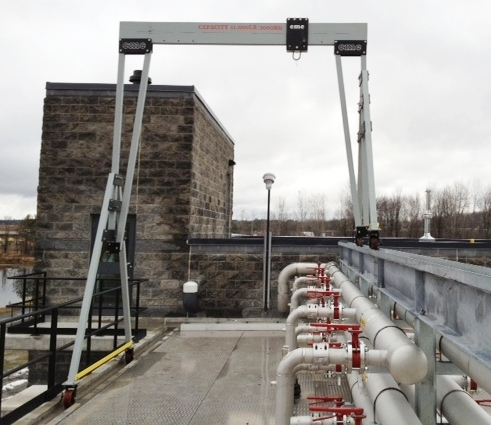A-frame hoists, also known as a gantry crane, are an excellent option for lifting and moving heavy loads in industrial and commercial settings. With their durable construction and reliable lifting capabilities, A-frame hoists are a popular choice for businesses that require efficient and safe material handling. The most popular type of A-frame hoists is an aluminum gantry crane.
What are A-frame hoists?
Gantry cranes are versatile lifting devices that are designed to be used in a variety of applications, including manufacturing, construction, and maintenance. They consist of two vertical legs that are connected by a horizontal beam at the top, forming an A-shape. A hoist or winch is then mounted on the horizontal beam, allowing for the lifting and lowering of heavy objects. The gantry may be constructed of various materials such as steel, either a heavy I beam steel crane, or a lightweight and portable aluminum gantry crane.
Benefits of A-frame hoists & Aluminum Cranes:
Versatility: A-frame hoists can be used in a variety of settings and applications, from lifting machinery and equipment to moving heavy materials on construction sites. Steel cranes are normally heavier and harder to move and aren’t as versatile.
Portability: A gantry crane hoist is designed to be portable, making them an excellent option for businesses that require a hoist that can be easily moved to different locations. Small aluminum gantries can be built by just one person. Lightweight aluminum cranes outfitted with four position swivel lock casters allow the operator to manually push the gantry while fully loaded.
Adjustability: A-frame hoists, especially aluminum gantries, have a beam with adjustable spans and legs with height positioning holes. Beams with an adjustable span allows the operator to change the clear span. Height positioning holes, not only allows the gantry not only have a adjustable height (ie. the i beam height for steel gantries), it also can compensate for uneven floors by placing the legs at different heights.
Customization: A-frame hoists can be customized to meet the specific needs of a business, including size, capacity, lifting height and beam length.
Safety: Different models are designed with certain safety features in mind. Common features are sturdy construction. Safety features like overload protection, and easy-to-use controls may be available on select models.
Cost-effective: A-frame gantry can be an affordable option for businesses that require efficient and reliable material handling without breaking the bank.
How to choose a A frame Gantry
Capacity
One of the most important factors to consider is the capacity of the hoist. You’ll want to choose a hoist that can handle the maximum weight of the loads you’ll be lifting. It’s important to note that the lifting capacity includes not only the weight of the load but also the weight of any rigging or attachments that will be used.
Height
The height of the hoist is another important factor to consider. You’ll want to choose a hoist that can reach the heights you need to lift and move your loads. A gantry that has adjustable height, will give the operator more flexibility to adjust heights for specific lifts. It’s also important to consider the clearance height, which is the distance between the bottom of the hoist and the ground. Make sure that the clearance height is sufficient for your needs.
Length of chain or cable
The length of the chain or cable is also important to consider. You’ll want to choose a hoist that has a chain or cable that is long enough to reach the distances you need. It’s also important to consider the minimum distance the hoist can lift or lower the load.
Type of lifting mechanism
A-frame hoists come with different types of hoist mechanisms, including electric, manual, and hydraulic. Electric hoists are powered by electricity and are easy to operate. Manual hoists are operated by hand and are ideal for situations where electricity is not available. Hydraulic hoists use hydraulic power to lift and lower loads and are ideal for heavy-duty applications. The hoist mechanism is typically attached to a beam trolley.
Mobility
A gantry crane is designed to be mobile, which makes them ideal for situations where you need to lift and move heavy loads to different areas of a job site or factory. Lightweight aluminum gantries make an ideal portable gantry. Heavier i-beam steel cranes are NOT considered portable gantry cranes by many users. If you need a hoist that is mobile, make sure that it has wheels or casters and that it can be easily moved.
Safety features
Finally, it’s important to consider the safety features of the hoist. Look for a hoist that has safety features such as overload protection, emergency stop buttons, and limit switches. These features will help to ensure that the hoist operates safely and that workers are protected from accidents.
Conclusion
In conclusion, choosing the right A-frame hoist requires careful consideration of several factors, including capacity, height, length of chain or cable, type of hoist mechanism, mobility, and safety features. By considering these factors and choosing the right model of hoist for your specific needs, you can make lifting and moving heavy items safer and more efficient.
At Easily Moved Equipment, we manufacture the broadest portfolio of aluminum A-frame hoists in North America! Contact us today to find out how we can help solve your lifting challenges!






0 Comments